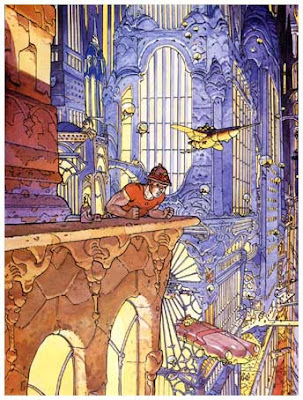Jean Giraud, best known as Moebius, passed away on Saturday. He was an influential and internationally acclaimed comic book artist, illustrator, and designer; he was also admired by artists as diverse as Frederico Fellini, Hayao Miyazaki, Stan Lee, and Alejandro Jodorowsky. Jean Giraud began drawing and writing comics in France in the late 1950s, and his major breakthrough was Blueberry, which he drew under the pseudonym Gir. This series was created together with the writer Jean-Michel Charlier in the major European comics magazine Pilote in 1963. Blueberry was an unconventional and gritty take on the Western genre, and became an international critical and commercial success.
However, Jean Giraud felt confined within the parameters of the comics industry of his time, as did many other artists. His move towards the development of an innovative visual language in the art of comics was evident in The Deviation, a fantasy story which was published in Pilote in 1973. The next key development was the formation of the comics art group Les Humanoïdes Associés, of which he was a founding member, and the publication of Métal Hurlant in 1974; the group’s influential magazine was subsequently published in the US as Heavy Metal.
In Métal Hurlant, Jean Giraud worked under the pseudonym Moebius, and began to create fantasy/science fiction stories, such as Arzach, which were groundbreaking in terms of both the art of comics, and the development of the fantasy/science fiction genre. He subsequently collaborated with Alejandro Jodorowsky in the comic book series The Incal, which started in 1981, and with Stan Lee in the Silver Surfer: Parable miniseries, which was published in 1988/1989; he furthermore worked as a conceptual artist in major science fiction films. In his later career, Moebius drew and wrote the diary-like series Inside Moebius between 2000 and 2010; he also returned to the Blueberry series, and revisited his early fantasy work with the album Arzak: L’Arpenteur in 2010.
On Monday, the front page of Libération featured a portrait of Moebius by Enki Bilal, a prominent European comic book artist of the following generation, who began his career in Pilote, and subsequently published his science fiction stories in Métal Hurlant, and Heavy Metal. The portrait includes an image of the flying pterodactyl-like creature, a reference to Moebius’ trademark Arzach series. Moreover, the phrase “la bande décimée” paraphrases la bande dessinée, which is the French term for comics. Moebius’ death has indeed been devastating; but does it mean that this art form has now been decimated?
In order to address this question, one would have to take under consideration the wider social, political, and artistic context of Moebius’ era; and as in many occasions in the history of art, this was a time of radical change. Moves such as the formation of Les Humanoïdes Associés and the publication of Métal Hurlant in the mid-70s, were part of a wider aesthetic rift in European comics, which in France included magazines such as L’Écho des Savanes and (À Suivre), leading to the rise of auteur comic book art. As Moebius himself put it in the documentary Moebius Redoux: A Life in Pictures, in that era “society was freeing itself in an extraordinary way, and needed new talents to create something new, something that fitted the times.”
This new trend was thus of similar significance to what La Nouvelle Vague represented in the context of film. Furthermore, the new artists and publications revolutionalised the expressive means of their medium, and contributed to the wider acknowledgement of comics as an autonomous art form. Aesthetic innovation, however, cannot overshadow the fact that the new trends remained male-dominated, and that content was more often than not problematic in terms of its representation of gender, despite efforts such as the publication of the feminist magazine Ah! Nana.
In his key works in the 1970s, such as The Deviation, Moebius breaks down the composition of the page, and merges its contents by negating the use of conventional frames; moreover, in Azrach he develops unusual visual perspectives to put forward an entirely mute storyline. His clean and plastic line is instantly identifiable, and so is his taste for science fiction with a sense of irrationalism in the vein of the Theatre of the Absurd, delivered with a subliminal countercultural flair. It is thus hardly surprising that Moebius has been thought of as an innovator; and for the same reason, remembering him has also the value of a call for innovation itself: the next unpredictable step forward.
Additional information on Moebius:
Moebius on his art, fading eyesight, and legend: ‘I am like a unicorn’
Geoff Bucher, Los Angeles Times, 2011
Moebius Redoux: A Life in Pictures Part 1 Part 2 Part 3
BBC Documentary (Dir. Hasko Baumann, Avanti Media 2007)







No comments:
Post a Comment